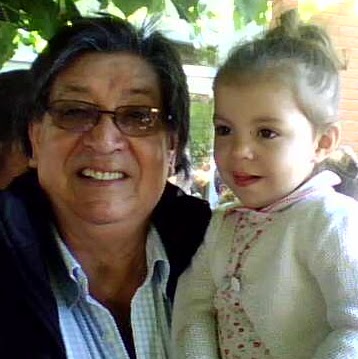Luis M Cabrera
age ~37
from Cleveland, OH
- Also known as:
-
- Luis F Cabrera
Luis Cabrera Phones & Addresses
- Cleveland, OH
- 3459 W 100Th St, Cleveland, OH 44111
Wikipedia References

Luis Cabrera (Chilean Footballer)

Luis Angel Cabrera
Name / Title
Company / Classification
Phones & Addresses
Journeyman
L Cabrera Painting Ltd
Painting Contractors
Painting Contractors
1029 116A St NW, Edmonton, AB T6J 7A5
7809916598, 7804350584
7809916598, 7804350584
Journeyman
L Cabrera Painting Ltd
Painting Contractors
Painting Contractors
7809916598, 7804350584
Resumes

3 Por 100 En Contrution
view sourcePosition:
3 POR 100 at CONTRUTION
Location:
Nueva York y alrededores, Estados Unidos
Industry:
Management Consulting
Work:
CONTRUTION Actualmente tiene este puesto de trabajo
3 POR 100
3 POR 100

Luis Cabrera
view sourceLocation:
United States

Luis Cabrera
view sourceLocation:
United States

Luis Cabrera
view sourceLocation:
United States

Luis Cabrera
view sourceLocation:
United States

Maintenance Technician En Hollywood Palms
view sourcePosition:
Maintenance Technician at Hollywood Palms
Location:
Miami/Fort Lauderdale y alrededores, Estados Unidos
Industry:
Farming
Work:
Hollywood Palms Actualmente tiene este puesto de trabajo
Maintenance Technician
Maintenance Technician
Isbn (Books And Publications)

Web Services Architecture and Its Specifications : Essentials for Understanding WS--
view sourceAuthor
Luis E. Cabrera
ISBN #
0735621624
Medicine Doctors

Luis R. Cabrera
view sourceSpecialties:
Internal Medicine
Work:
MCCI Medical Group
9740 SW 40 St, Miami, FL 33165
3052275300 (phone), 3054853209 (fax)
9740 SW 40 St, Miami, FL 33165
3052275300 (phone), 3054853209 (fax)
Education:
Medical School
Inst Tech De Santo Dom (intec), Esc De Med, Fac De Med, Santo Domingo
Graduated: 1994
Inst Tech De Santo Dom (intec), Esc De Med, Fac De Med, Santo Domingo
Graduated: 1994
Procedures:
Vaccine Administration
Electrocardiogram (EKG or ECG)
Electrocardiogram (EKG or ECG)
Conditions:
Abnormal Vaginal Bleeding
Acne
Acute Bronchitis
Allergic Rhinitis
Angina Pectoris
Acne
Acute Bronchitis
Allergic Rhinitis
Angina Pectoris
Languages:
English
Spanish
Spanish
Description:
Dr. Cabrera graduated from the Inst Tech De Santo Dom (intec), Esc De Med, Fac De Med, Santo Domingo in 1994. He works in Miami, FL and specializes in Internal Medicine. Dr. Cabrera is affiliated with Kendall Regional Medical Center.

Luis Manuel Baez Cabrera
view sourceSpecialties:
Psychiatry
Us Patents
-
Ply Wire Sensor System For A Tire
view source -
US Patent:7185534, Mar 6, 2007
-
Filed:Aug 3, 2005
-
Appl. No.:11/196083
-
Inventors:George Michael Stoila - Tallmadge OH, US
William Randall Dutt - Copley OH, US
Shaun Matthew Immel - Massillon OH, US
Eric Christian Osborn - Medina OH, US
John Michael Maloney - Uniontown OH, US
David Paul Schweitzer - North Canton OH, US
Normajean Selby - Cuyahoga Falls OH, US
Luis Antonio Cabrera Arevalo - Hartville OH, US -
Assignee:The Goodyear Tire & Rubber Company - Akron OH
-
International Classification:G01M 17/02
-
US Classification:73146
-
Abstract:A ply wire sensor system is provided for a tire carcass ply in a green tire carcass having a toroidal shape, the tire carcass ply having a plurality of spaced apart ply wires extending across the toroidal shape. The sensor system includes a wire sensor mounted in close proximity with the tire carcass ply, the wire sensor detecting the presence of a proximal ply wire; and means for establishing relative movement between the wire sensor and the tire carcass whereby the plurality of spaced apart ply wires are sequentially placed into proximity with the wire sensor. The wire sensor generates sequential data indicative of at least one ply wire parameter of the plurality of spaced apart ply wires.
-
Method For Evaluating Ply Wire Anomalies In A Tire
view source -
US Patent:7416624, Aug 26, 2008
-
Filed:Aug 3, 2005
-
Appl. No.:11/196170
-
Inventors:George Michael Stoila - Tallmadge OH, US
William Randall Dutt - Copley OH, US
Shaun Matthew Immel - Massillon OH, US
Eric Christian Osborn - Medina OH, US
John Michael Maloney - Uniontown OH, US
David Paul Schweitzer - North Canton OH, US
Normajean Selby - Cuyahoga Falls OH, US
Luis Antonio Cabrera Arevalo - Hartville OH, US -
Assignee:The Goodyear Tire & Rubber Company - Akron OH
-
International Classification:B29D 30/06
G01M 17/02 -
US Classification:156 64, 156123, 1561307
-
Abstract:A method for detecting ply wire anomalies in a tire carcass ply having a plurality of spaced apart ply wires extending across a tire carcass, the method comprising the steps: constructing a green tire carcass in a diametrically expanded toroidal configuration, the carcass comprising a pair of beads, the carcass ply extending from bead to bead, at least one crown layer covering the carcass ply and having a peripheral skirt region; and sidewalls covering the carcass ply and extending from the beads to the crown layer and having edge portions intersecting the crown layer; mounting a wire sensor apparatus proximal to the tire carcass ply, the wire sensor apparatus including a wire sensor for detecting the presence of a proximal ply wire; establishing relative movement between the wire sensor and the tire carcass whereby the plurality of spaced apart ply wires are sequentially placed into proximal relationship with the wire sensor; and generating sequential data from the wire sensor indicative of at least one ply wire parameter of the plurality of spaced apart ply wires.
-
Geodesic Tire And Method Of Manufacture
view source -
US Patent:20110146874, Jun 23, 2011
-
Filed:Nov 29, 2010
-
Appl. No.:12/955083
-
Inventors:Robert Allen Losey - Kent OH, US
Samuel Patrick Landers - North Canton OH, US
Thulasiram Gobinath - Hudson OH, US
Luis Antonio Cabrera - Hartville OH, US -
International Classification:B60C 9/02
B60C 9/18
B29D 30/08
B32B 37/00 -
US Classification:152526, 152562, 156117, 156 64
-
Abstract:A method of making a tire comprising the steps of providing a core; forming a first layer of ply by winding a strip of one or more rubber coated cords onto the core in a geodesic pattern extending from a first shoulder to a second shoulder opposite said first shoulder and being tangent to the bead at a location between said first shoulder and said second shoulder.
Plaxo

Luis Cabrera
view sourceChicago, ILSenior Photographer at Face Photo Inc.

LUIS CABRERA
view sourceCOSMOS

Luis Cabrera
view sourceBroker at Tropical Homes & Commercial Properties

Luis Cabrera
view sourcePresidente &Genneral Manager at laca international...

Luis cabrera
view sourceASDA
Flickr
Myspace
Googleplus

Luis Cabrera
Work:
Brookdale Hospital - EMT
Jamaica Hospital - EMT
Kingsbrook Jewish Medical Center - EMT
American medical response - EMT
Metrocare Ambulance - EMT
Jamaica Hospital - EMT
Kingsbrook Jewish Medical Center - EMT
American medical response - EMT
Metrocare Ambulance - EMT
Relationship:
Married
Tagline:
Full time lifesaver, roaming the streets of Brooklyn at night..

Luis Cabrera
Work:
ForestCity Enterprises - Creative Professional
Loudigi.com - Freelance Designer (2012)
Loudigi.com - Freelance Designer (2012)
About:
Creative Pro based in Cleveland. Web+Motion Graphics+Photo. Techie, gamer, and all around party guy. Fiesta!
Tagline:
Earth without art is just Eh

Luis Cabrera
Work:
Sears, Roebuck and Company
Education:
E.S.T 105

Luis Cabrera
Education:
UC Irvine - Criminology
About:
Chill. Determined. Focused.
Bragging Rights:
Graduated high school with High Honors

Luis Cabrera
Work:
SITEL - GERENTE (1997-2004)
About:
Soy directivo de ampru
Tagline:
Tengo 12 nietos y 1 bis nieto

Luis Cabrera
Work:
LC PROYECTOS - PROYECTISTA
Education:
IUTAJS - CONSTRUCCION CIVIL
Tagline:
CONFIAMOS EN DIOS

Luis Cabrera
Work:
LIBRERIA UNIVERSAL - GERENTE
Education:
UNL

Luis Cabrera
Work:
Bagel boy - Truck driver (2011)
Education:
Youthbuild - GED,Carpentry
Classmates

Luis Cabrera
view sourceSchools:
Elgin H.S. Elgin IL 1960-1964
Community:
Deanna Kolberg, Octavio Marquez

Luis Cabrera
view sourceSchools:
Ohio City Elementary School Ohio City OH 1991-1995

Luis Cabrera (Paisa)
view sourceSchools:
Sotero Figueroa Escuelas Rio Piedras NJ 1968-1972
Community:
Hiram Mendez, Edwin Medina

Luis Cabrera
view sourceSchools:
Carmen Belen Veiga High School Juana Diaz NJ 1981-1985
Community:
Arturo Guzman, Ovidio Burgos, Carlos Nazario, Russell Theisen, Lusbell Reyes, Ines Negron

Luis Cabrera
view sourceSchools:
Fenster High School Tucson AZ 1988-1992
Community:
Stephanie Levy, Julie Nenninger, Steve Mcrae, Dan Black

Luis Cabrera
view sourceSchools:
South Lakes High School Reston VA 1988-1992
Community:
Scott Scott, Hannah Cannon

Luis Cabrera
view sourceSchools:
Museum Middle School Yonkers NY 2001-2005

Luis Cabrera
view sourceSchools:
Ridgewood Intermediate School 93 Ridgewood NY 1997-2001
Community:
Harold Phillips
Youtube

Jose Luis Cabrera Gzalez
view source
Pedro Luis Cabrera
view source
Jose Luis Cabrera
view source
Luis Cabrera
view source
Jorge Luis Cabrera Reyes
view source
Luis Cabrera
view source
Dennis Luis Cabrera Mendoza
view source
Jos Luis Cabrera
view sourceGet Report for Luis M Cabrera from Cleveland, OH, age ~37













